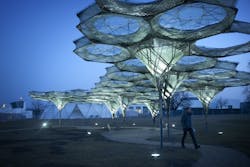Bionic Baldachin: Robotics and Architecture
The Elytra Filament pavilion was inspired by the fibrous structures on the forewings of flying beetles (elytra). The pavilion’s design and manufacture was automated with structural modeling computations and an industrial robot manufacturing the architectural components.
Elytra’s canopies weigh only 9kg/m2 and each of its 40 hexagonal components takes Kuka—the industrial robot—about three hours to fabricate. Kuka was programmed to fabricate the cellular canopies and seven columns, according to the structural simulation testing determined by the Institute of Building Structures and Structural Design.
Kuka’s winding technology winds composite materials developed at the Univ. of Stuttgart to harnesses the strength of the carbon fibers that are reinforced as they become part of woven structural components. Each hexagonal cell is made of resin-soaked glass and carbon fibers wound onto a hexagonal frame before hardening. Its final form of densely wound fibers is independent from each column.
